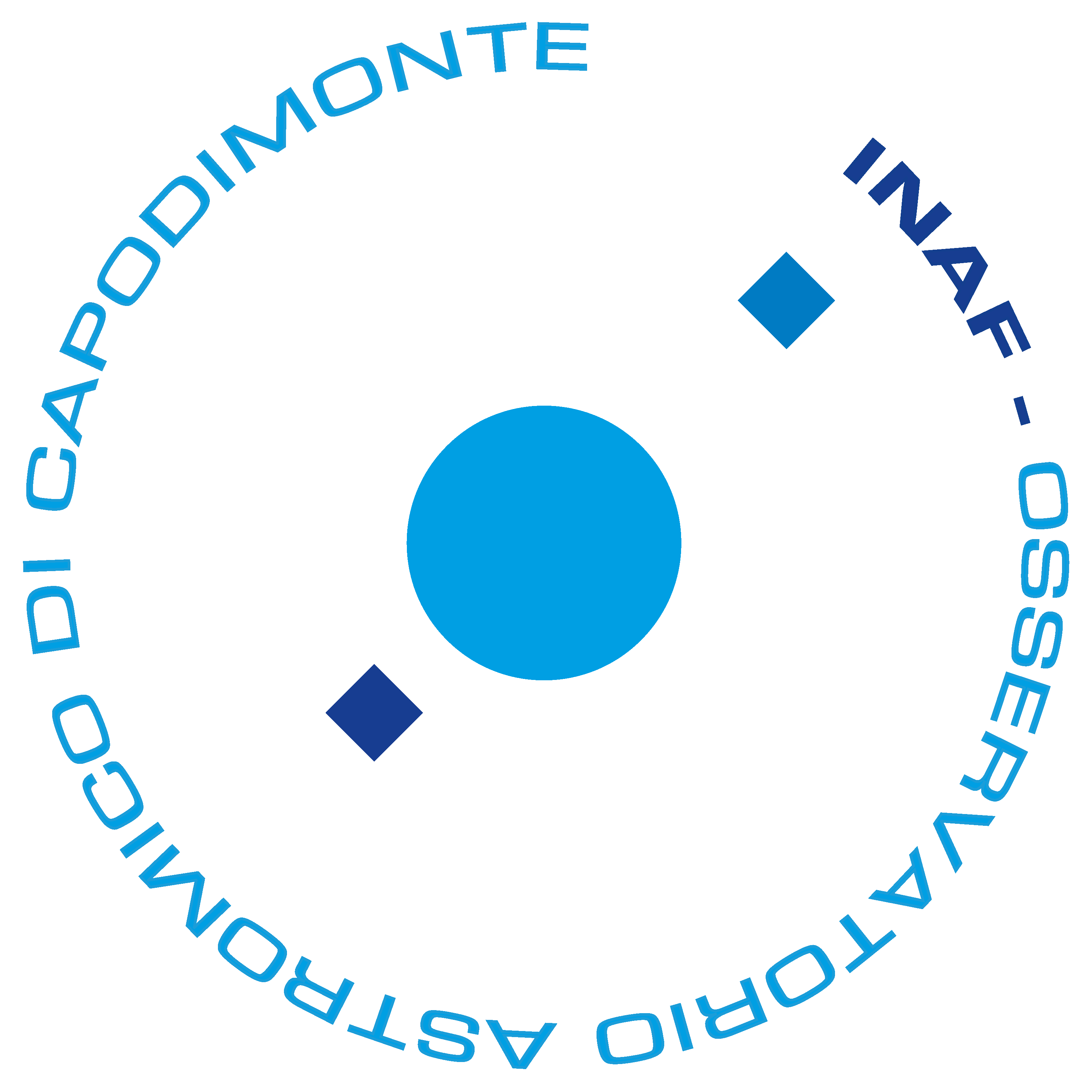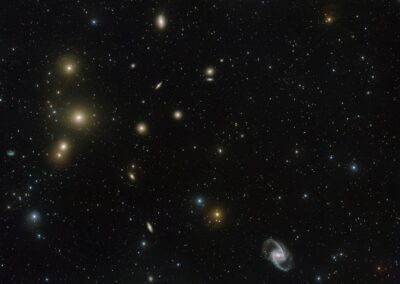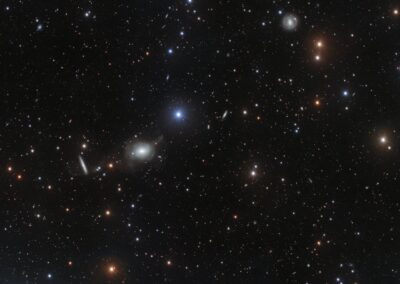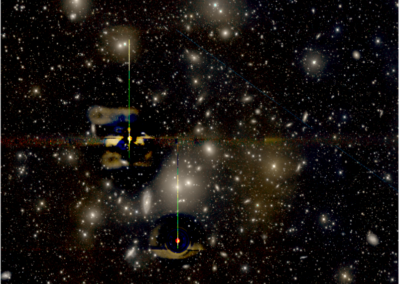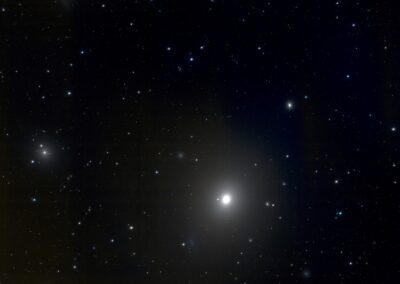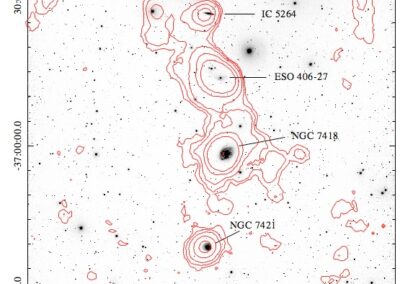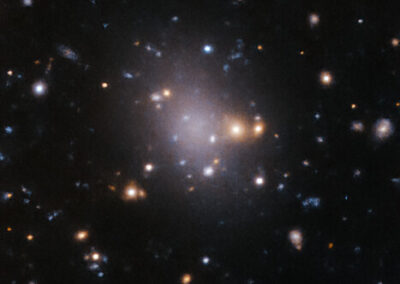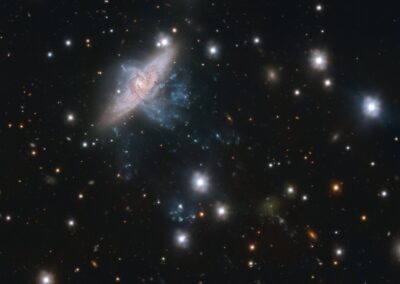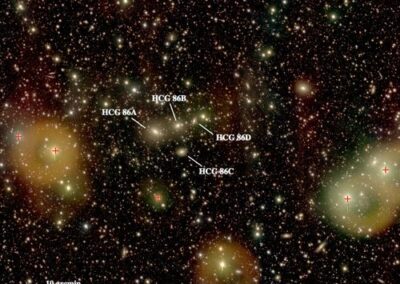“VEGAS:
VST Early-type GAlaxy Survey
VEGAS is a deep multi-band (u’g’r’i’) imaging survey, carried out with the ESO VLT Survey Telescope (VST). VST is a 2.6-m wide-field optical survey telescope, located at ESO Paranal Observatoryy“
Science
Exploring the low surface brightness (LSB) universe is one of the most challenging tasks in the era of the deep imaging and spectroscopic surveys.
It is however a crucial ingredient to map the mass assembly of galaxies at all scales and all environments and thus constrain their formation within the Lambda-Cold Dark Matter paradigm.
In this framework, clusters of galaxies are expected to grow over time by accreting smaller groups. During the infall process, the material stripped from the galaxy outskirts builds up the stellar halos and the intracluster light (ICL; see e.g. Contini et al. 2014; Cui et al. 2014; Pillepich et al. 2018). These are diffuse and very faint (μg > 26 mag/arcsec2) components made of stars stripped from satellite galaxies, also in the form of streams and tidal tails, with multiple stellar population and complex kinematics, which are still growing at the present epoch.
VEGAS science goals
to map the light distribution and colors out to 8-10 Re and down to the faint surface brightness levels of μg ≃ 31 mag/arcsec2, μr ≃ 28 mag/arcsec2; μi ≃ 27 mag/arcsec2
to study of the galaxy structure and its faint stellar halo, including the diffuse light component, inner substructures as signatures of recent cannibalism events, inner disks and bars
detection of the external low-surface brightness structures in galaxies, like tidal tails, stellar streams and shells and study the connection with environment
for galaxies in the local universe (D<50 Mpc), to census and study the globular clusters and galaxy satellites in the outermost regions of the host galaxy
the full will provide essential statistical constraints on theoretical models and enable discrimination among competing galaxy formation theories. Ongoing projects
planned works in 2019 – 2021
VEGAS/FDS SCIENCE TOPIC LED BY
STUDENT
STATUS
VEGAS: IC 1459 group E. Iodice, M. spavone A. Cattapan (MsC) completed:
paper published
FDS: Stellar halos in the ETGs of Fornax cluster M. Spavone completed:
paper published
FDS: GCs catalogue in FDS area M. Cantiello completed:
paper published
FDS: LTGs in FornaxA M.A. Raj M.A. Raj (PhD) completed:
paper published
VEGAS: Hydra I cluster (LSB features + stellar halos + ICL) E. Iodice ongoing
NGC3314A Letter published 2021, A&AL 651, L11
VEGAS: ICL in groups of galaxies M. Spavone R. Ragusa (PhD) ongoing
HCG86 paper published 2021, A&A 651, 39
VEGAS: Ultra-diffuse galaxies in IC1459 group D.A. Forbes J. Gannon (PhD) completed:
paper published
2020, A&A 626, 66
VEGAS: Stellar halos in the M3G galaxies M. Spavone & D. Krajnovic completed:
paper published
2021, A&A 649, 161
VEGAS: Dorado group of galaxies R. Rampazzo ongoing
published papers:
2021, JApA 42, 31
2020, A&A, 643, 176
FDS: Study of the bright galaxies in Fornax Cluster E. Iodice completed:
paper published
VEGAS: Census of the Ultra-diffuse galaxies in VEGAS (Ultra-VEGAS project) E. Iodice ongoing
published papers:
2021, A&A submitted
2020, A&A, 642, 48
2020, A&A, 626, 66
2019, MNRAS, 494, 5293
VEGAS: The dwarf galaxies population in the Hydra I cluster A. La Marca A. La Marca (MsC) ongoing
paper accepted in A&A 2021
VEGAS: ICL in massive clusters at D>150 Mpc M. Spavone ongoing
VEGAS: GCs analysis in NGC3379 & NGC5018 M. Cantiello & M. Paolillo M. Mirabile (MsC) ongoing
VEGAS-LSS: Mapping the large scale structure of the Fornax-Eridanus & Hydra I-Centaurus superclusters E. Iodice, M. Spavone, M.A. Raj started: first data acquired in Dec 2020new run in Nov 2021
VEGAS: Optical counterpart of the ETGs Radio loud I. Prandoni started: the planned sample is partially acquired (inserire tabella) Science overview & plans in 2020-2022
study of the large-scale structure around groups and clusters, including the unexplored regions of voids and filaments, down to the LSB regime, VEGAS-LSS project. An extension of this science case has been proposed as letter of intent for the future VST operation after 2022;
study the lowest stellar mass regime, typical for the low-density environments as groups of galaxies, to fill the gap in the comparison with the theoretical predictions across a large range of stellar mass (PhD project of Rossella Ragusa, at INAF-OAC Naples);
identify and study a large number (~1300) of ultra-diffuse galaxies (UDGs) in a wide range of environments (from groups to clusters of galaxies), UltraVEGAS project.
Vegas Team
VEGAS P.I.
Dr. Enrichetta Iodice
Staff Astronomer
INAF- Astronomical Observatory of Capodimonte,
via Moiariello, 16 – I80131 Napoli, Italy
Web: http://www.na.astro.it/~iodice/Enrichetta-Iodice.html
email: enrichetta.iodice@inaf.it VEGAS co-P.I. & data reduction leader
Dr. Marilena Spavone Staff Astronomer
INAF- Astronomical Observatory of Capodimonte,
via Moiariello, 16 – I80131 Napoli, Italy
email: marilena.spavone@inaf.it VEGAS Team & collaboration
M. Arnaboldi – European Southern Observatory (ESO), Garching, Germany
E. Bannikova – Institute of Radio Astronomy of National Academy of Sciences of Ukraine, Ukraine
S. Brough – School of Physics, University of New South Wales, NSW 2052, Australia
M. Cantiello – INAF-Osservatorio Astronomico di Teramo, Teramo, Italy
M. Capaccioli – University of Naples, Naples, Italy S. Ciroi – University of Padova, Italy
A. Cooper – Institute for Computational Cosmology, Durham, UK
E.M. Corsini – University of Padova, Italy
G. D’Ago – PUC, Santiago, Chile
E. Dalla Bontà – University of Padova, Italy
D. De Cicco – PUC, Santiago, Chile
E. Emsellem – European Southern Observatory (ESO), Garching, Germany
J. Falcon-Barroso – Instituto de Astrofìsica de Canarias (IAC), La Laguna, Spain (FDS co-I)
D. Forbes – Swinburne University of Technology, Hawthorn, Australia
L. Greggio – INAF-Osservatorio Astronomico di Padova, Italy
E. Held – INAF-Osservatorio Astronomico di Padova, Italy
M. Hilker – European Southern Observatory (ESO), Garching, Germany
D. Krajnović – Leibniz-Institut für Astrophysik Potsdam (AIP), Potsdam, Germany
A. La Marca – Master Student, INAF-Osservatorio Astronomico di Capodimonte & University of Naples, Italy
S. Mieske – European Southern Observatory (ESO), Garching, Germany (FDS co-I)
M. Mirabile – Master Student, INAF-Osservatorio Astronomico di Capodimonte & University of Naples, Italy
N. R. Napolitano - School of Physics and Astronomy, Sun Yat-sen University, Zhuhai Campus, China (FDS co-I)
M. Paolillo – University of Naples, Naples, Italy
A. Pasquali – Zentrum fur Astronomie, Heidelberg, Germany
R. Peletier – Kapteyn Astronomical Institute, University of Groningen, Groningen, The Netherland (FDS co-I)
A. Pizzella – University of Padova, Italy
I. Prandoni – INAF – Istituto di Radioastronomia, Bologna, Italy
M.A. Raj – Post-doc, INAF-Osservatorio Astronomico di Monte Porzio, Roma, Italy
R. Ragusa – PhD, INAF-Osservatorio Astronomico di Capodimonte, Napoli, Italy
R. Rampazzo – INAF-Osservatorio Astronomico di Padova, Italy
M. Rejkuba – European Southern Observatory (ESO), Garching, Germany
P. Schipani – INAF-Osservatorio Astronomico di Capodimonte, Napoli, Italy (PI VST)
C. Spiniello – Sub-Department of Astrophysics, Department of Physics, University of Oxford, UK
G. van de Ven – Department of Astrophysics, University of Vienna, Austria A. Venhola – University of Oulu, Oulu, Finland (FDS co-I)
Vegas Targets
| n. | target name | galaxy environment | available filters | covered area [deg] | Total Exp. time [hrs] | Observing strategy | Date release | Status of the data |
| 1 | ESO157-IG024 | group | gr | 1 | 5 | standard | — | reduced |
| 2 | ESO 383-76 | group | gr | 1 | 5 | standard | — | scheduled |
| 3 | HCG 86 | compact group | gri | 1 | 7 | standard | — | published |
| 4 | HCG 90 | compact group | gri | 1 | 6.6 | standard | — | observed |
| 5 | IC 1453 | group | gri | 1 | 2.5 | standard | — | to be completed |
| 6 | IC1459 | group | gri | 2.9 | 7 | step-dither | DR1 | published |
| 7 | IC 4296 | Centaurus cluster | gr | 1 | 4.5 | standard | — | reduced |
| 8 | IC 4329 | cluster A3574 | gri | 1 | 6.5 | — | observed | |
| 9 | IC 5328 | group | gr | 1 | 5 | standard | — | to be completed |
| 10 | NGC 0596 | group | gr | 2 | 9.2 | standard | — | reduced |
| 11 | NGC 0612 | group | gr | 1 | 5 | standard | — | reduced |
| 12 | NGC 1332 | Eridanus cluster | gr | 6 | 5 | step-dither | — | reduced |
| 13 | NGC 1395 | Eridanus cluster | gr | 6 | 5 | step-dither | — | observed |
| 14 | NGC 1398 | Eridanus cluster | gr | 3 | 5 | step-dither | — | observed |
| 15 | NGC 1407 | Eridanus cluster | gr | 6 | 6 | step-dither | — | reduced |
| 16 | NGC 1453 | group | gr | 1 | 5 | standard | — | reduced |
| 17 | NGC 1482 | Eridanus cluster | gr | 1 | 5 | standard | — | observed |
| 18 | NGC 1533 | Dorado group | gr | 1.4 | 4.6 | standard | DR1 | published |
| 19 | NGC 1553 | Dorado group | gri | 1.2 | 4.1 | standard | — | reduced |
| 20 | NGC 2434 | group | gri | 1 | 6.5 | standard | — | scheduled |
| 21 | NGC 2876 | group | gri | 1 | 5 | standard | — | observed |
| 22 | NGC 2685 | group | gri | 1 | 5 | standard | — | observed |
| 23 | NGC 3100 | group | gr | 1 | 5 | standard | — | reduced |
| 24 | NGC 3115 | group | ugi | 1.2 | 8.2 | standard | DR1 | published |
| 25 | NGC 3136 | group | gri | 1 | 6.4 | standard | — | reduced |
| 26 | NGC 3250 | group | gr | 1 | 5 | standard | — | reduced |
| 27 | NGC3258 | group | gri | 2 | 16 | standard | — | reduced |
| 28 | NGC 3268 | group | gr | 2 | 8.6 | step-dither | — | reduced |
| 29 | NGC3311 | Hydra I cluster | gr | 2 | 5 | step-dither | — | published |
| 30 | NGC 3379 | group | ugr | 3.9 | 6.2 | step-dither | DR1 | reduced |
| 31 | NGC 3640 | group | ugri | 2 | 19 | step-dither | — | reduced |
| 32 | NGC3923 | group | gi | 6.5 | 2.2 | step-dither | DR1 | published |
| 33 | NGC 4105 | group | gri | 1 | 5 | standard | — | to be completed |
| 34 | NGC 4365 | Virgo cluster | gi | 1 | 3.2 | standard | — | reduced |
| 35 | NGC 4373 | group | gri | 5 | 1 | standard | — | observed |
| 36 | NGC 4472 | Virgo cluster | gi | 1.6 | 3.4 | standard | DR1 | published |
| 37 | NGC 4636 | Virgo cluster | gr | 2 | 6.4 | step-dither | — | reduced |
| 38 | NGC 4696 | Centaurus cluster | ugr | 3 | 17.4 | step-dither | — | reduced |
| 39 | NGC 4697 | Virgo cluster | gri | 2 | 15 | step-dither | — | reduced |
| 40 | NGC 5018 | group | ugi | 3.9 | 5.4 | step-dither | DR1 | published |
| 41 | NGC 5044 | group | gi | 5.8 | 2.1 | step-dither | DR1 | published |
| 42 | NGC5813 | group | gr | 2 | 9.2 | — | reduced | |
| 43 | NGC 5846 | group | gi | 5.3 | 1 | step-dither | DR1 | published |
| 44 | NGC 6868 | group | gri | 2 | 11.2 | step-dither | — | reduced |
| 45 | NGC 6876 | group | gri | 1 | 6.5 | standard | — | observed |
| 46 | NGC 7232 | triplet | gr | 1 | 5 | standard | — | observed |
| 47 | NGC 7358 | group | gri | 1 | 6.5 | standard | — | observed |
| 48 | NGC 7727 | shell galaxy | gr | 1 | 6 | standard | — | observed |
| 49 | PGC 015524 | cluster | gr | 1 | 4.6 | standard | — | published |
| 50 | PGC 048896 | cluster | gr | 1 | 4.6 | standard | — | to be completed |
| 51 | PGC 049940 | cluster | gr | 1 | 4.6 | standard | — | published |
| 52 | PGC 007748 | cluster | gr | standard | — | published |
Vegas&Fds Publications
“1. La Marca A., Iodice E., Cantiello M. et al., 2021, A&A submitted: Galaxy populations in the Hydra I cluster from the VEGAS survey. II. The ultra-diffuse galaxy population
2. La Marca A., Peletier R., Iodice E. et al., 2021, A&A accepted ( arXiv:2112.00711 ) : Galaxy populations in the Hydra I cluster from the VEGAS survey. I. Optical properties of a large sample of dwarf galaxies
3. Venhola A., Peletier R., Salo H. et al. 2021, A&A accepted (arXiv:2111.01855) : The Fornax Deep Survey (FDS) with VST XII: Low surface brightness dwarf galaxies in the Fornax cluster
4. Iodice E., La Marca A., Hilker M. et al. 2021 A&A Letter 652, L11: Formation of an ultra-diffuse galaxy in the stellar filaments of NGC 3314A: Caught in the act?
5. Iodice E., Spavone M., Raj M.A. et al. 2021, The ESO Messenger n. 183, pg.25: The VST Early-type GAlaxy Survey: Exploring the Outskirts and Intra-cluster Regions of Galaxies in the Low-surface- brightness Regime
6. Ragusa R., Spavone M., E. Iodice et al. 2021, A&A, 651, 39: VEGAS: A VST Early-type GAlaxy Survey.VI. The diffuse light in HCG~86 from the ultra-deep VEGAS images
7. Rampazzo, R.; Mazzei, P.; Marino, A.; et al. 2021, JApA 42, 31: Dorado and its member galaxies II: A UVIT picture of the NGC 1533 substructure
8. Iodice E., Spavone M., Raj M. A. et al. 2021, arXiv:2102.04950: The VST Early-type GAlaxy Survey (VEGAS) data release 1
9. Spavone M., D. Krajnović, E. Emsellem et al. 2021, A&A 649, 161: On the assembly history of massive galaxies. A pilot project with VEGAS deep imaging and M3G integral field spectroscopy.
10. Su, Alan H.; Salo, Heikki; Janz, Joachim et al. 2021, A&A 647, 100: The Fornax Deep Survey (FDS) with the VST XI. The search for signs of preprocessing between the Fornax main cluster and Fornax A group
11. Iodice E., Cantiello M., Hilker M., Rejkuba M.. et al., 2020, A&A, 642, 48: The first detection of ultra-diffuse galaxies in the Hydra I cluster from the VEGAS survey
12. Raj A., Iodice E., Napolitano N.R. et al., 2020, A&A, 604, 137 : The Fornax Deep Survey with VST. X. The assembly history of the bright galaxies and intra-group light in the Fornax A subgroup
13. Cantiello M., Venhola A., Grado A. et al., 2020, A&A, 639, 136: The Fornax Deep Survey with VST. IX. Catalog of sources in the FDS area with an example study for globular clusters and background galaxies
14.Spavone M., Iodice E., van de Ven G., et al., 2020, A&A, 639, 14: The Fornax Deep Survey with VST. VIII. Connecting the accretion history with the cluster density
15. Forbes D.A., Dullo B., Gannon J. et al., 2020, MNRAS, 494, 5293: Ultradiffuse galaxies in the IC1459 group from VEGAS survey
16. Iodice E., Spavone M., Cattapan A. et al., 2020, A&A, 635, 3: VEGAS: a VST Early-type GAlaxy Survey. V. IC1459 group: Mass assembly history in low-density environments
17.Raj A., Iodice E., Napolitano N.R. et al., 2019, A&A, 628, 4: The Fornax Deep Survey with VST. VII. Evolution and Structure of Late Type Galaxies inside the Virial Radius of the Fornax Cluster
18. Forbes D., Gannon J., Couch W., Iodice E., et al., 2019, A&A, 626, 66:An ultra diffuse galaxy in the NGC5846 group from the VEGAS survey
19. Venhola A., Peletier R. et al. 2019, A&A, 625, 143: The Fornax Deep Survey with VST VI. Optical properties of the dwarf galaxies in the Fornax cluster
20. Cattapan A., Spavone M., Iodice E. et al., 2019, ApJ, 874, 130: VEGAS: a VST Early-type GAlaxy Survey. IV. NGC 1533, IC 2038 and IC 2039: an interacting triplet in the Dorado group
21. Iodice E., Spavone M., Capaccioli M., Peletier R. et al., 2019, A&A, 623, 1: The Fornax Deep Survey with VST. V. Exploring the faintest regions of the bright early-type galaxies inside the virial radius : VEGAS-SSS II: Comparing the globular cluster systems in NGC3115 and NGC1399 using VEGAS and FDS survey data
22. Spavone M., Iodice E., Capaccioli M. et al., 2018, ApJ, 864, 149: VEGAS: A VST Early-type GAlaxy Survey. III. Mapping the galaxy structure, interactions and intragroup light in the NGC5018 group
23. Cantiello M., D’Abrusco R., Spavone M. et al., 2018, A&A, 611, 93: VEGAS-SSS II: Comparing the globular cluster systems in NGC3115 and NGC1399 using VEGAS and FDS survey data
24. Venhola A., Peletier R. et al. 2018, A&A, 620, 165: The Fornax Deep Survey with VST IV. A size and magnitude limited catalog of dwarf galaxies in the area of the Fornax cluster
25. Iodice E., Spavone M., Cantiello M., D’Abrusco R. et al., 2017, ApJ, 851, 75: Intra-cluster patches of baryons in the core of the Fornax cluster
26. Iodice E., Spavone M., Capaccioli M., Peletier R. et al., 2017, ApJ, 839, 21: The Fornax Deep Survey with VST. II. A Two-phase assembly caught on act
27. Spavone M., Capaccioli M., Napolitano A. et al., 2017, A&A, 603, 38: VEGAS: A VST Early-type GAlaxy Survey II. Photometric study of giant ellipticals and their stellar halos
28. Venhola A., Peletier R., Laurikainen E. et al. 2017, A&A, 608, 142: The Fornax Deep Survey with VST III. Ultra diffuse Galaxies (UDGs) and Low Surface Brightness (LSB) galaxies in the center of the Fornax cluster
29. D’Abrusco R., Cantiello M., Paolillo M. et al., 2016, ApJL, 819, 31: : The Extended Spatial Distribution of Globular Clusters in the Core of the Fornax Cluster
30. Iodice E., Capaccioli M., Grado A. et al., 2016, ApJ, 820, 42 : The Fornax Deep Survey with VST. I. The Extended and Diffuse Stellar Halo of NGC 1399 out to 192 kpc
31. Cantiello M., Capaccioli M., Napolitano N.R., et al. 2015, A&A, 576, 14: VEGAS-SSS. A VST early-type galaxy survey: analysis of small stellar systems. Testing the methodology on the globular cluster system in NGC 3115.
32. Capaccioli M., Spavone M., Grado A., et al. 2015, A&A, 581, 10: VEGAS: A VST Early-type GAlaxy Survey. I. Presentation and test case on the field of NGC 4472
33. Iodice E., Capaccioli M., Spavone M., et al. 2015, A&A, 574, 111: : A forming wide polar-ring galaxy at z ∼ 0.05 in the VST Deep Field of the Fornax cluster”
Data Reduction
“First VEGAS observations (2014-2016) have been processed with the VST-tube pipeline specialized for the VST-OmegaCam observations
(see Grado et al. 2012; Capaccioli et al. 2015)
Since 2018, the VEGAS data are reduced with the AstroWise data-reduction pipeline
Dr. Marilena Spavone, at INAF-Astronomical Observatory of Capodimonte is leading and coordinating this task.
Both pipelines perform the standard pre-reduction steps, gain harmonisation of the 32 CCDs, illumination correction and, for the i band, defringing. Relative and absolute astrometric and photometric calibrations are applied before creating the final co-added image mosaics.
In addition, there are two tasks to perform the sky subtraction, depending on the adopted observing strategy :
– fitting of the background with a surface, typically a 2D polynomial, to the pixel values of the mosaic;
– for images acquired with the step-dither observing strategy, an average sky frame is obtained from exposures taken as close as possible, in space and time, to the scientific ones.
Observing strategies
Step-dither:
the brightest and most extended galaxies (with mB < 10 mag and a major axis diameter larger than 5 arcmin), a good background estimate is achieved by adopting the step-dither observing sequence (see Iodice et al. 2016, 2017, Spavone et al. 2017, Iodice et al. 2019).
It consists of a cycle of short exposures, 5 x 150 sec on the target (science frame) and 5 x 150 sec on the sky frame.
Standard:
For less extended objects, the sky background can be estimated on the science frame, by using a polynomial surface fit over the entire frame (see Capaccioli et al. 2015). In this case, the adopted observing strategy is the standard diagonal dithers to cover the CCD gaps.”
The Fornax Deep Survey (FDS) with VST
“DS is a new, multi-band imaging survey of the Fornax cluster of galaxies FDS is a joint project based on the GTO survey FOrnax Cluster Ultra deep Survey (FOCUS, P.I. R. Peletier) and VEGAS (P.I. E. Iodice)
FDS aims to cover the whole Fornax cluster out to the virial radius (~0.7 Mpc), with an area of about 26 square degrees around the central galaxy NGC1399 (top panel), and the region where NGC1316 is located, on the SW (left panel)”
Image Gallery
NGC3314A&B
Color-composite (gr) VST image of the system of two spiral galaxies NGC3314A (in front) and NGC3314B (behibd)
Fornax A sub-group
Fornax A sub-group Color-composite (ugri) image of the SW group of th Fornax cluster of galaxy centred on NGC1316
NGC5018 group of galaxies
Color-composite (ugri) VST image of the group of galaxies centered on NGC5018
The giant elliptical galaxy NGC4472
Color-composite (gi) VST image of the elliptical galaxy in the Virgo
IC1459 GROUP
VST mosaic (in the g band) of the group of galaxies centred on IC1459. The red contours indicates the emission of neutral HI gas
Ulta-diffuse galaxy in the Hydra I cluster
Color-composite (gr) VST image of an ultra-diffuse galaxy in the Hydra I cluster
Caught in a spiral
The image shows a pair of overlapping spiral galaxies, NGC 3314a and b, in the top left, caught in a majestic cosmic dance — captured by ESO’s VLT Survey Telescope (VST). But don’t let the perspective fool you! They are, in fact, not interacting at all. The two galaxies, located between 117 and 140 million light-years away in the constellation of Hydra, are actually physically unrelated and only appear to overlap when viewed from Earth. This unique alignment gives astronomers the opportunity to measure many properties of the galaxies, such as how dust absorbs starlight, and hence gain insight into their composition and evolution. There is another hidden secret in this picture if you look closely at the lower right region: beyond this stunning cosmic dance you will find a faint yellowish smudge, the signature of an ultra-diffuse galaxy (UDG). UDGs are objects as large as the Milky Way but with 100 – 1000 times fewer stars. These galaxies are extremely faint and lack star-forming gas, which makes them appear almost like a smudge in the night sky. This UDG, named UDG 32, is one of the faintest and most spread out galaxies in the Hydra I cluster. This image was taken as part of a much larger project, the VST Early-type Galaxy Survey (VEGAS), whose goal is to investigate very faint structures in galaxy clusters — large groups of galaxies held together by gravity. The study, led by Enrichetta Iodice from the Istituto Nazionale di Astrofisica in Italy, suggests that UDG 32 may have formed out of the filaments stemming from NGC 3314a, but more observations are needed to confirm this.
Vegas Collaboration Meeting
“13 -15 July 2022
Committees
Program
Participants
Dates
Registration
Motivation:
VEGAS will end in 2022, in P108 ESO period. The latest observing runs will be executed in P109 as carry over from P107.
This meeting aims at making an overview of the project, providing the main achievements and results.
Main goals of the meeting:
How VEGAS contributed to the panorama of the (ongoing) deep imaging surveys?
Which is the expertise that we have collected in ~10years of the project?
How well performed the VST as optical survey telescope compared to the others of its class?
What about the cross-collaborations (i.e. FDS) and follow-ups using other facilities (e.g., FORS2, MUSE, MeerKAT)?
Given that, how we can contribute to the upcoming science with the upcoming facilities for large surveys (e.g. EUCLID, LSST)?
“
Organizing committees
“
SOC
M. Arnaboldi (ESO)
M. Cantiello (INAF)
E.M. Corsini (Univ. of Padova)
D. Forbes (Swinburne Univ. of Technology )
L. Greggio (INAF)
E. Iodice, chair (INAF)
S. Mieske (ESO)
M. Paolillo (Univ. of Naples)
P. Schipani (INAF)
M. Spavone, co-chair (INAF)
LOC
R. Ragusa, chair (INAF)
R. Aiello (INAF)
F. Bencivenga (INAF)
M. Gargano (INAF)
A. La Marca (Univ. of Groningen)
M. Mirabile (Univ. of Naples)
Workshop program
“
Workshop program
July 12
19:00 – Welcome aperitif
July 13 (tabella)
Time slot Speaker Title
9:00 – 9:10 E. Iodice Welcome
9:10 – 9:30 M. Capaccioli The young age of galaxy photometry
Session1: Overview on theoretical predictions
chair: D. Forbes
9:30 – 9:50 R.S. Remus Stellar halos and accreted mass fraction
9:50 – 10:10 C. Pulsoni Stellar halos: comparison between observations and simulations
10:10 – 10:30 L. Kimmig Tidiness of Outer Space: A Universal Density Profile for Outer Stellar Halos
10:30 – 11:00 Coffee-break
Session 2: Ongoing deep imaging surveys
11:00 – 11:20 P.A. Duc Review on the main science topics and results from MATLAS
11:20 – 11:40 D. Martinez-Delgado Survey of stellar tidal streams beyond the Local Group, including amateur and DESI LS data
11:40 – 12:00 I. Trujillo Deep imaging of stellar halos and UDGs with GTC and Gemini telescopes
12:00 – 12:20 M. Montes ICL from HST
12:30 – 14:30 Lunch
chair: M. Arnaboldi
14:30 – 14:50 M. Kluge Stellar halos and ICL in clusters of galaxies with Wendelstein Telescope Wide Field Imager
14:50 – 15:10 C. Mihos Results on the Virgo cluster down to the LSB regime (ICL and UDGs)
15:10 – 15:30 M. D’Onofrio LBT Imaging of Galactic Halos and Tidal Structures (LIGHTS) survey
15:30 – 15:50 A. Cortesi Multiwavelengths narrow band surveys: overview, synergies and future perspectives
15:50 – 16:10 F. Buitrago Finding the limits of galaxies up to z = 1
16:10 – 16:40 Coffee-break
16:40 – 17:00 J. Méndez Abreu The BEARD project
17:00 – 17:20 J. Carlin Results on the LSB regime from HSC@Subaru
July 14 (tabella)
Time slot speaker Title
Session 3: VEGAS science projects
9:00 – 9:20 E. Iodice The VEGAS project
chair: E. Iodice
9:20 – 9:40 M. Spavone Stellar halos in ETGs & LSB features
9:40 – 10:00 R. Ragusa ICL in groups and clusters
10:00 – 10:20 M. A. Raj Mass assembly in the Fornax Eridanus supercluster
10:20 – 10:40 R. Rampazzo Structure of galaxies in groups: optical vs UV in Dorado group
10:40 – 11:10 Coffee-break
11:10 – 11:30 A. La Marca LSB galaxies in the Hydra I cluster
11:30 – 11:45 N. Bellucco LSB galaxies in the Centaurus cluster
11:45 – 12:05 M. Cantiello VEGAS-Small Stellar Systems
12:05 – 12:20 M. Mirabile GCs in groups of galaxies
12:20 -12:35 N. Hazra GCs in the Hydra I cluster
12:35 – 15:30 Long Lunch break
Session 4: VEGAS follow-up & collaborations
chair: M. Paolillo
15:30 – 15:45 J. Hartke Kinematic tracers vs photometry in galaxy outskirts
15:45 – 16:00 I. Ruffa The AGN fuelling/feedback processes in nearby radio galaxies: insights from multi-wavelength data
16:00 – 16:20 R. Peletier/E.Iodice The Fornax Deep Survey with VST
16:20 – 16:40 F. Maccagni/P. Serra The Fornax MeerKAT survey
16:40 – 17:00 N.R. Napolitano Fornax Cluster VLT Spectroscopic Survey (FVSS): status of the project
17:00 – 17:20 Coffee-break
17:20 – 17:35 A. Chaturvedi FVSS: Kinematical characterisation of globular clusters in the Fornax galaxy cluster
17:35 – 17:50 G. Riccio LMXBs in intra-cluster GCs in the Fornax cluster
17:50 – 18:10 M. Sarzi The Fornax3D project
18:10 – 18:30 T. Saifollahi
Detection of Extragalactic UCDs and GCs in Wide-Imaging Surveys
20:00 Social dinner
July 15 (tabella)
Time slot speaker Title
Session 4: VEGAS follow-up & collaborations
chair: L. Greggio
9:00 – 9:20 D. Forbes Ultra Diffuse Galaxies: Galaxies at the Extreme
9:20 – 9:40 E. Iodice The LEWIS project: on the nature of UDGs in the Hydra I cluster
Session 6: future surveys & facilities
9:40 – 10:00 M. Arnaboldi The ESO Phase 3: how to ensuring the legacy value of science data products
10:00 – 10:20 A. Borlaff The realm of LSB: from HST to Euclid
10:20 – 10:40 R. Scaramella Euclid: project status
10:40 – 11:10 Coffee-break
11:00 – 11:20 C. Conselice On the local universe science from the EUCLID survey
11:20 – 11:40 M. Brescia Vera Rubin Observatory LSST: project status & in-kind proposals
11:40 – 12:00 S. Brough LSB universe from the Vera Rubin Observatory LSST perspective
12:00 – 12:20 M. Cirasuolo ELT: status & science
12:20 – 12:30 E. Iodice Summary
12:30 – 14:30 Lunch
Important Dates
February 28, 2022: deadline to submit the registration form (available )
April 30, 2022: deadline for room reservation at a special fare (see )
June 17, 2022: deadline for the fee payment (find details )
June 30, 2022: book transfers (NAPLES/PIMONTE and return)
July 10, 2022: final program
July 13, 2022: conference starts
Registration
“To attend the workshop
fill the registration form, by February 28, 2022 – CLOSED
pay the registration fee by June 17, 2022
Registration fee:
Registration fee can only be payed through this portal: https://inaf.bnl.plugandpay.it/
Detailed description are provided in this file (collegamento al pdf Fee Payment Instructions – RB007B1) Fee includes: coffee-breaks, welcome (on July 12, 2022), transfers from to Naples (airport/railway station), social dinner and conference material
ATTENDANCE STATUS FEE
In person Senior 150 euro
In person Student 50 euro
Remote Any 50 euro
“
Conference Location
“
The workshop will take place at the Sant’Angelo Resort
“”an oasis of greenery between Amalfi and Sorrento, overlooking Vesuvius and the Gulf of Naples””
located in the city of Pimonte.
We have blocked a number of rooms at a special fare (~100 euro/person/day full board for a single room; ~120 euro/person/day for double room with a single use).
Book your room sending and email to info@resortsantangelo.it
Pay attention to address “”VEGAS workshop”” in your request! And specify if you are interested in full board or half board.
“
Social Events – Book here
“
Friday, July 15, 4-7 PM: Food and wine excursion
Departure from Pimonte Resort Santangelo at 4 PM.
Transfer by bus (20 seats).
Arrival in Terzigno at 5 PM – Tenuta Le Lune del Vesuvio.
Guided tour of the factory.
Four hectares of greenery at about 300 meters above sea level, headquarters in defense of the typical traditional Vesuvian products, in the middle of the Vesuvius National Park, in front of the wonders of ancient Pompeii, the island of Capri and the Gulf of Naples.
Visit of the vineyard, of the vegetable garden, with animals and visit of the winery.
Proposal for a suggestive taste experience, immersed in nature and in contact with the aromas and flavors of the Vesuvius National Park.
Light buffet: tasting of the factory’s production oil on pieces of fresh bread; bruschetta with cherry tomatoes and garden vegetables. Typical aged cheese platter with jams, in combination with 3 DOC wines of the Factory.
Return to the Santangelo Resort with departure 6.30 PM and arrival at 7.00 PM
Cost: € 45 per person (minimum number of 20 persons)
Saturday, July 16, 9:30 AM – 4 PM:
Valle delle Ferriere naturalistic excursion
Departure from Pimonte Santangelo at 9.30 AM
The Valle delle Ferriere Oriented Nature Reserve is an oasis located in Scala, near the Pontone, along the paths that lead from the mountains to the center of Amalfi. It is a small but deep corner hidden in the Lattari Mountains, where spectacular waterfalls meet the archeology of the Amalfi Republic. A special place where nature has preserved a unique flora and fauna in the world, thanks to very particular atmospheric conditions.
Transfer by bus (20 seats)
Arrival Pontone di Scala – Amalfi Coast at 10.30 AM
Trekking route Pontone – Valle delle Ferriere with guide with itinerant story (about 3 hours of walking between the two ways, at a gentle pace).
Guided tour of the Valle delle Ferriere Oriented Reserve.
Picnic stop with basket prepared by Resort Santangelo.
Return with departure from Pontone di Scala (around 4 PM).
Cost: 60 € per person ( minimum number of 20 persons)
“
How to reach Piemont
“Private bus, booked from the workshop LOC (pick your slot here):
— July 11 —
5:00 PM from railway station “Piazza Garibaldi” – meeting point: Metropark Napoli
5:30 PM from Capodichino airport – meeting point: Alibus stop
— July 12 —
2:00 PM from railway station “Piazza Garibaldi” – meeting point: Metropark Napoli
2:30 PM from Capodichino airport – meeting point: Alibus stop
9:00 PM from railway station “Piazza Garibaldi” – meeting point: Metropark Napoli
9:30 PM from Capodichino airport – meeting point: Alibus stop
— July 15 —
2:00 PM from Sant’Angelo Resort to Capodichino airport and railway station “Piazza Garibaldi”
— July 16 —
7:00 AM from Sant’Angelo Resort to Capodichino airport and railway station “Piazza Garibaldi”
“
Public transport (see also here):
“From Capodichino airport,
– take the Alibus to Immacolatella – Porta di Massa (this is terminal).
– by walk (~450m), reach the Sita bus stop in Viale Europa, and take the bus n.5080
From railway station Napoli Piazza Garibaldi,
– take the underground L1 to Piscinola and stop to “”Università””
– by walk (~350m) reach the Sita bus stop in Viale Europa, and take the bus n.5080
Partecipants
“Name Affiliation Attendance
M. Arnaboldi ESO – Garching in person
N. Bellucco Università di Padova in person
E. Bannikova INAF & Ukraine in person
A. Borlaff NASA remote
F. Buitrago University of Valladolid in person
M. Brescia INAF-Osservatorio Astronomico di Capodimonte in person
S. Brough UNSW remote
M. Cantiello INAF-Osservatorio Astronomico d’Abruzzo in person
M. Capaccioli INAF in person
J. Carlin Vera C. Rubin Observatory remote
A. Chaturvedi ESO – Garching in person
M. Cirasuolo ESO – Garching remote
A. Cooper National Tsing Hua University TBD
C. Conselice University of Manchester remote
E.M. Corsini Univ. of Padova in person
A. Cortesi Observatório do Valongo, Brazil in person
G. D’Ago Pontificia Universidad Católica de Chile remote
M. D’Onofrio Dep. of Physics & Astronomy, Univ. of Padova in person
R. D’Souza Vatican Observatory in person
P.A. Duc
Observatoire astronomique de Strasbourg in person
D.A. Forbes Swinburne Univ. in person
M. Gargano INAF-Astronomical Observatory of Capodimonte in person
O. Gerhard Max-Planck-Institute for Ex. Physics in person
L. Greggio INAF-Astronomical Observatory of Padova in person
M. Gullieszik INAF-Astronomical Observatory of Padova in person
L. Kimmig University of Munich in person
M. Kluge University Observatory Munich, Germany in person
J. Hartke ESO / Oxford in person
N. Hazra
Gran Sasso Science Institute/INAF-OAAb in person
M. Hilker ESO, Garching in person
E. Iodice INAF-Astronomical Observatory of Capodimonte in person
A. La Marca SRON in person
P. Lonare Tor Vergata University, National Institute of Astrophysics (INAF-OAAb) and Sapienza University in person
F. Maccagni ASTRON / INAF-OAC in person
C. Martinez-Lombilla UNSW Sydney in person
D. Martinez-Delgado Instituto de Astrofisica de Andalucia- Consejo Superior de Investigaciones Cientificas remote
J. Mendez-Abreu Universidad de La Laguna/Instituto de Astrofisica de Canarias in person
S. Mieske ESO, Chile remote
C. Mihos
Case Western Reserve University remote
M. Mirabile INAF-Astronomical Observatory of Abruzzo in person M. Montes STScI in person
N.R. Napolitano Sun Yat-sen University, Zhuhai Campus, China in person
M. Paolillo Univ. of Naples in person
A. Pizzella Università di Padova, Italy in person
E. Portaluri INAF – OAAb in person
C. Pulsoni MPE, Garching in person
R. Ragusa INAF-Astronomical Observatory of Capodimonte in person
M.A. Raj
INAF-Astronomical Observatory of Rome in person
R. Rampazzo INAF-Astronomical Observatory of Padova in person
M. Rejkuba ESO, Garching in person
S. Remus University of Munich in person
G. Riccio National Centre of Nuclear Research, Warsaw, Poland in person
I. Ruffa Cardiff University in person
R. Russo University of Padova, Italy in person
M. Sarzi Armagh Observatory & Planetarium in person
R. Scaramella INAF-Astronomical Observatory of Rome in person
P. Schipani INAF-Astronomical Observatory of Capodimonte in person
M. Spavone INAF-Astronomical Observatory of Capodimonte in person
C. Spiniello
Oxford University in person
T. Saifollahi Kapteyn Astronomical Institute in person
I. Truijllo Instituto de Astrofisica de Canarias in person
G. van de Ven University of Vienna remote”
